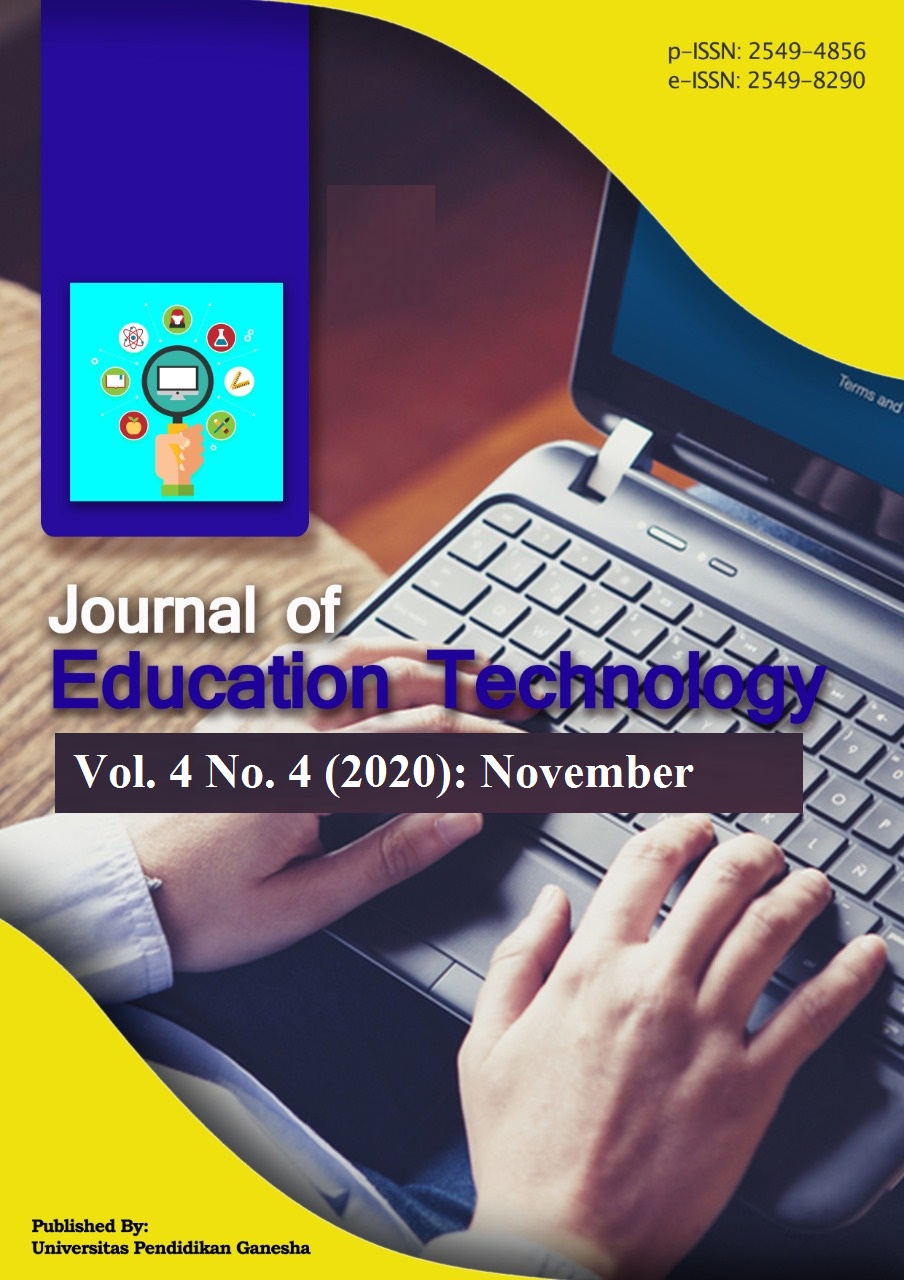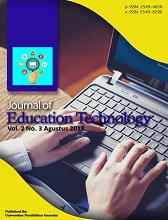Contribution of Learning Style, Learning Creativity and Exploratory Interest to Students' Simulation and Digital Communication Learning Outcomes during the Covid-19 Pandemic
DOI:
https://doi.org/10.23887/jet.v4i4.29701Keywords:
learning style, creativity, learning outcomesAbstract
Many problems occur when online learning is carried out, this problem is for most students prefer face-to-face learning. Online learning is not fun because the methods used in learning are monotonous and online learning causes students to experience stress. This study aims to reveal the contribution of learning styles, creativity, and exploratory interest to the learning outcomes of simulation and digital communication during the COVID-19 pandemic. This type of research is quantitative with correlational research methods. The population of this study was students of class X. The sampling technique was proportional random sampling, with a total sample of 80 students. The data analysis technique used is quantitative data analysis techniques. Based on the research results, it was found that the data were normal, linear, and did not occur multicollinearity. The test results at a significance level of α 0.05 (95% confidence level) obtained a rx1y value of 0.380 with an r table of 0.220 because rcount> rtable, the first hypothesis was accepted. Then the rx2y value is 0.695 with rtable 0.220, because rcount> rtable, the second hypothesis is accepted. Then the rx3y value is 0.770 with r table 0.220, because rcount> rtable, the third hypothesis is accepted. Furthermore, the value of rx1x2x3y is 0.772 with rtable 0.220, because rcount> rtable, the fourth hypothesis is accepted. And supported by the value of Fcount = 37.262 and Ftable = 2.723 to obtain Fcount> Ftable. (37,262> 2,723). So, it can be concluded that there is a contribution of learning style, creativity, and exploratory interest to the learning outcomes of simulation and digital communication during the 19 covid pandemics
References
Budiwibowo, S. (2016). Hubungan Minat Belajar Siswa Dengan Hasil Belajar Ips Di Smp Negeri 14 Kota Madiun. Gulawentah:Jurnal Studi Sosial, 1(1), 60. https://doi.org/10.25273/gulawentah.v1i1.66
Chania, Y., Haviz, M., & Sasmita, D. (2017). Hubungan Gaya Belajar Dengan Hasil Belajar Siswa Pada Pembelajaran Biologi Kelas X Sman 2 Sungai Tarab Kabupaten Tanah Datar. Sainstek : Jurnal Sains Dan Teknologi, 8(1), 77. https://doi.org/10.31958/js.v8i1.443
Dekker, S., Lee, N. C., Howard-Jones, P., & Jolles, J. (2012). Neuromyths in education: Prevalence and predictors of misconceptions among teachers. Frontiers in Psychology, 3(OCT), 1–8. https://doi.org/10.3389/fpsyg.2012.00429
Dong, C., Cao, S., & Li, H. (2020). Young children’s online learning during COVID-19 pandemic: Chinese parents’ beliefs and attitudes. Children and Youth Services Review, 118(June), 105440. https://doi.org/10.1016/j.childyouth.2020.105440
Ghofur, A., Nafisah, D., & Eryadini, N. (2016). Gaya Belajar dan Implikasinya Terhadap Kemampuan Berfikir Kritis Mahasiswa. Journal An-Nafs: Kajian Penelitian Psikologi, 1(2), 166–184. https://doi.org/10.33367/psi.v1i2.285
Henriksen, D., Richardson, C., & Shack, K. (2020). Mindfulness and creativity: Implications for thinking and learning. Thinking Skills and Creativity, 37(July), 1–10. https://doi.org/10.1016/j.tsc.2020.100689
Huang, T. C. (2019). Do different learning styles make a difference when it comes to creativity? An empirical study. Computers in Human Behavior, 100, 252–257. https://doi.org/10.1016/j.chb.2018.10.003
Hwang, G. J., Wang, S. Y., & Lai, C. L. (2020). Effects of a social regulation-based online learning framework on students’ learning achievements and behaviors in mathematics. Computers and Education, 160, 104031. https://doi.org/10.1016/j.compedu.2020.104031
Liu, Q., Huang, J., & Zhou, Z. (2020). Self-expansion via smartphone and smartphone addiction tendency among adolescents: A moderated mediation model. Children and Youth Services Review, 119(June), 105590. https://doi.org/10.1016/j.childyouth.2020.105590
Magdalena, S. M. (2015). The Relationship of Learning Styles, Learning Behaviour and Learning Outcomes at the Romanian Students. Procedia - Social and Behavioral Sciences, 180(November 2014), 1667–1672. https://doi.org/10.1016/j.sbspro.2015.05.062
Mahitsa, M., & Mahardini, A. (2020). Analisis Situasi Penggunaan Google Classroom pada Pembelajaran Daring Fisika. Jurnal Pendidikan FIsika, VIII(2), 215–224. https://doi.org/http://dx.doi.org/10.24127/jpf.v8i2.3102 ANALISIS
Martinez, E. G., & Tuesca, R. (2019). Learning styles and gross anatomy assessment outcomes at a Colombian School of Medicine. Educacion Medica, 20(2), 79–83. https://doi.org/10.1016/j.edumed.2017.12.012
Maulana, H. A. &, & Iswari, R. D. (2020). Analisis Tingkat Stres Mahasiswa Terhadap Pembelajaran Daring Pada Mata Kuliah Statistik Bisnis di Pendidikan Vokasi. Jurnal Ilmiah Kependidikan, 14(1), 17–30. https://doi.org/10.30595/jkp.v14i1.8479
Mayora, E., Junaidi, J., & Rusdi, R. (2018). Hubungan Antara Kreativitas Siswa dengan Hasil Belajar Matematika Siswa Kelas VIII SMP Negeri 1 X Koto Di Atas Kabupaten Solok Tahun Pelajaran 2017/2018. JURING (Journal for Research in Mathematics Learning), 1(1), 254. https://doi.org/10.24014/juring.v1i3.7274
Mishra, D. L., Gupta, D. T., & Shree, D. A. (2020). Online Teaching-Learning in Higher Education during Lockdown Period of COVID-19 Pandemic. International Journal of Educational Research Open, 100012. https://doi.org/10.1016/j.ijedro.2020.100012
Patricia, A. (2020). College Students’ Use and Acceptance of Emergency Online Learning Due to COVID-19. International Journal of Educational Research Open, 100011. https://doi.org/10.1016/j.ijedro.2020.100011
Putri, F. E., Amelia, F., & Gusmania, Y. (2019). Hubungan Antara Gaya Belajar dan Keaktifan Belajar Matematika Terhadap Hasil Belajar Siswa. Edumatika: Jurnal Riset Pendidikan Matematika, 2(2), 83. https://doi.org/10.32939/ejrpm.v2i2.406
Radyuli, P., & Rahmat, V. (2017). Korelasi Disiplin Belajar dan Kreativitas Belajar Terhadap Minat Belajar Teknologi Informasi dan Komunikasi ( TIK ). Jurnal Pendidikan Dan Teknologi Informasi, 4(2), 262–271. file:///C:/Users/SONY-PC/AppData/Local/Temp/69-61-1-PB.pdf
Sambada, D. (2012). Peranan Kreativitas Siswa Terhadap Kemampuan Memecahkan Masalah Fisika Dalam Pembelajaran Kontekstual. Jurnal Penelitian Fisika Dan Aplikasinya (JPFA), 2(2), 37. https://doi.org/10.26740/jpfa.v2n2.p37-47
Sari, I. N., Saputri, D. F., & Sasmita. (2016). Prestasi Belajar Fisika Pada Siswa Kelas Xi Ipa Sma Negeri 1 Galing Kabupaten Sambas. Jurnal Edukasi Matematika Dan Sains, 4(2), 108–114. https://media.neliti.com/media/publications/77020-ID
Sawawa, D., Solehudin, A., & Sabri, S. (2018). Pengaruh Faktor Internal Dan Eksternal Siswa Terhadap Hasil Belajar Pada Mata Pelajaran Mekanika Teknik Dan Elemen Mesin. Journal of Mechanical Engineering Education, 5(1), 21. https://doi.org/10.17509/jmee.v5i1.12615
Siregar, M. W., & Situmorang, J. (2016). Upaya Meningkatkan Aktivitas Dan Hasil Belajar Alat Ukur Dengan Menggunakan Multimedia Interaktif Pada Siswa Kelas X Di Smk Al-Washliyah 4 Medan. Jurnal Teknologi Informasi & Komunikasi Dalam Pendidikan, 3(1), 68–79. https://doi.org/10.24114/jtikp.v3i1.5006
Sudjana Nana. (2005). Dasar-dasar ProsesBelajar Mengajar. Sinar Baru Algensindo.
Syafi’i, A., Marfiyanto, T., & Rodiyah, S. K. (2018). Studi Tentang Prestasi Belajar Siswa Dalam Berbagai Aspek Dan Faktor Yang Mempengaruhi. Jurnal Komunikasi Pendidikan, 2(2), 115. https://doi.org/10.32585/jkp.v2i2.114
Wahyuni, A., & Kurniawan, P. (2018). Hubungan Kemampuan Berpikir Kreatif Terhadap Hasil Belajar Mahasiswa. Matematika, 17(2), 1–8. https://doi.org/10.29313/jmtm.v17i2.4114
Wang, R., Lowe, R., Newton, S., & Kocaturk, T. (2020). Task complexity and learning styles in situated virtual learning environments for construction higher education. Automation in Construction, 113(February), 103148. https://doi.org/10.1016/j.autcon.2020.103148
Wassahua, S. (2016). Analisis Gaya Belajar Siswa Terhadap Hasil Belajar Matematika Pada Materi Himpunan Siswa Kelas Vii Smp Negeri Karang Jaya Kecamatan Namlea Kabupaten Buru. Jurnal Matematika Dan Pembelajarannya, 2(1), 105–126. http://jurnal.iainambon.ac.id/index.php/INT/article/view/310/242
Wong, G. L. H., Wong, V. W. S., Thompson, A., Jia, J., Hou, J., Lesmana, C. R. A., Susilo, A., Tanaka, Y., Chan, W. K., Gane, E., Ong-Go, A. K., Lim, S. G., Ahn, S. H., Yu, M. L., Piratvisuth, T., & Chan, H. L. Y. (2020). Management of patients with liver derangement during the COVID-19 pandemic: an Asia-Pacific position statement. The Lancet Gastroenterology and Hepatology, 5(8), 776–787. https://doi.org/10.1016/S2468-1253(20)30190-4
Yeftha, Haryanto, Z., & Saputra, Y. W. (2020). Pengaruh Minat Terhadap Hasil Belajar Geografi Dengan Model Inkuiri Terbimbing di SMAN 3 Samarinda Influence of Interest Against Geography Learning Outcomes With the Guided Inquiry Model at SMAN 3 Samarinda. Jurnal Geoedusains, 1, 15–27. https://doi.org/https://doi.org/10.31764/paedagoria.v11i2.2347
Zagoto, M. M., Yarni, N., & Dakhi, O. (2019). Perbedaan Individu dari Gaya Belajarnya Serta Implikasinya Dalam Pembelajaran. Jurnal Review Pendidikan Dan Pengajaran, 2(2), 259–265. https://journal.universitaspahlawan.ac.id/index.php/jrpp/article/view/481/0
Zahri, T. N., Yusuf, A. M., & S, N. (2017). Hubungan Gaya Belajar dan Keterampilan Belajar dengan Hasil Belajar Mahasiswa Serta Implikasinya dalam Pelayanan Bimbingan dan Konseling di Fakultas Ilmu Pendidikan Universitas Negeri Padang. Konselor, 6(1), 18. https://doi.org/10.24036/02017615734-0-00.
Downloads
Published
How to Cite
Issue
Section
License
Authors who publish with the Journal of Education Technology agree to the following terms:
- Authors retain copyright and grant the journal the right of first publication with the work simultaneously licensed under a Creative Commons Attribution License (CC BY-SA 4.0) that allows others to share the work with an acknowledgment of the work's authorship and initial publication in this journal.
- Authors are able to enter into separate, additional contractual arrangements for the non-exclusive distribution of the journal's published version of the work (e.g., post it to an institutional repository or publish it in a book), with an acknowledgment of its initial publication in this journal.
- Authors are permitted and encouraged to post their work online (e.g., in institutional repositories or on their website) prior to and during the submission process, as it can lead to productive exchanges, as well as earlier and greater citation of published work. (See The Effect of Open Access)


















